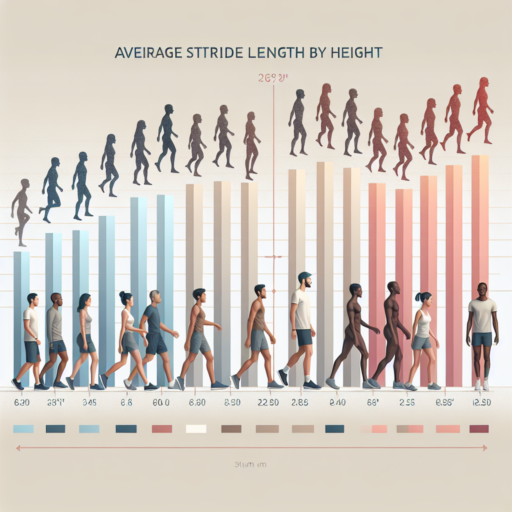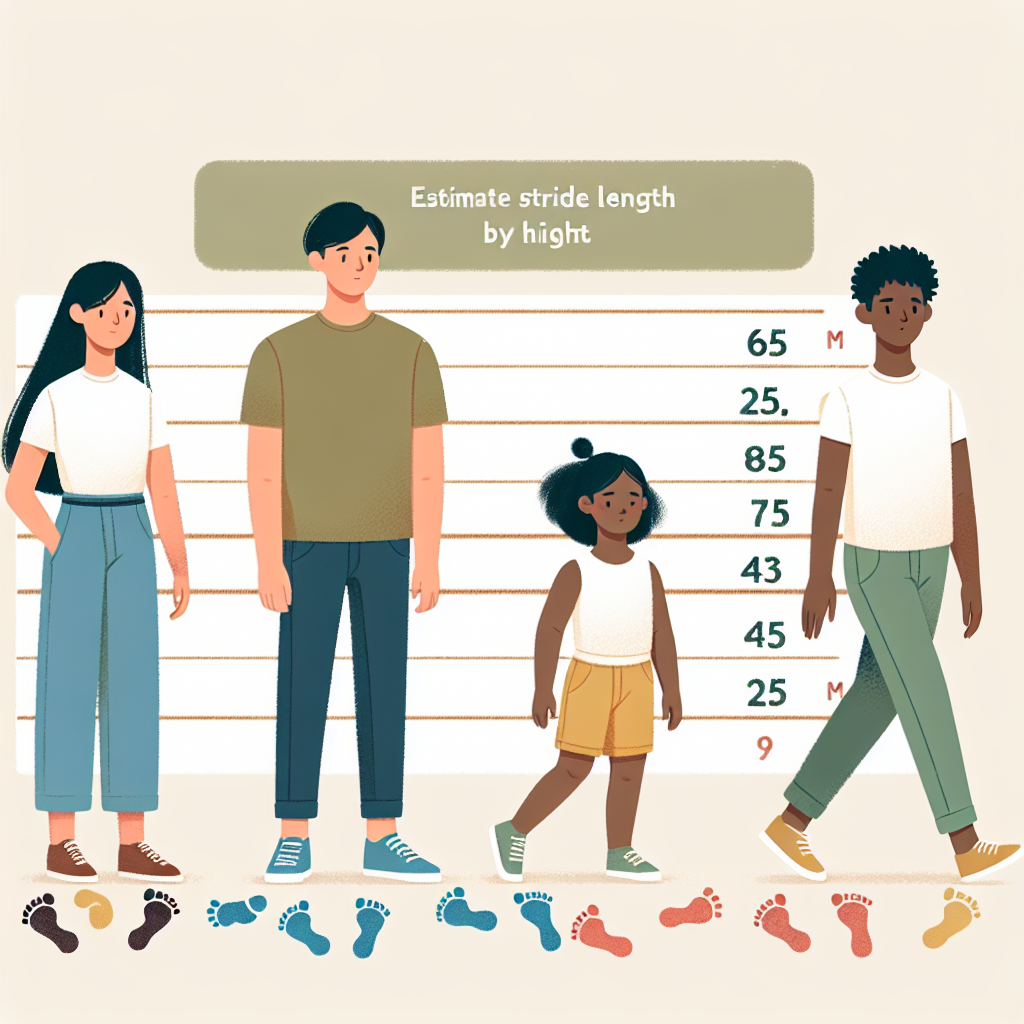Understanding Average Stride Length by Height
Understanding the correlation between stride length and height is crucial for athletes, fitness enthusiasts, and individuals embarking on a walking or running regimen. Stride length, typically measured from heel to heel, varies significantly among individuals and is influenced by leg length, which is directly associated with a person’s height. This discussion delves into how height impacts stride length and offers insights on optimizing your walking or running efficiency.
The Role of Height in Determining Stride Length: It’s a well-established fact that taller individuals generally have longer strides. However, it’s crucial to understand that optimal stride length is not merely about covering more ground with fewer steps. Instead, it’s about finding a balance that enhances efficiency while reducing the risk of injury. By analyzing the average stride lengths of people across various height categories, it becomes evident how height influences stride patterns and why personalized stride assessments are essential for setting realistic fitness goals.
Customizing Stride Length for Height and Efficiency
Finding the perfect stride length involves more than just calculations and averages. It requires a tailored approach that considers one’s height, flexibility, strength, and overall physical condition. For those seeking to optimize their stride, it’s advisable to undergo professional gait analysis. Such analyses can provide valuable recommendations, ensuring your stride not only compleases with height-related averages but also aligns with your personal health and fitness objectives.
How to Measure Your Stride Length Accurately
Knowing your stride length is essential for athletes, walkers, and fitness enthusiasts aiming to track their physical activities accurately. It can help in setting realistic fitness goals, improving walking or running efficiency, and selecting the right fitness equipment. But how do you measure your stride length accurately?
Firstly, find a clear, flat surface where you can walk or run for at least 20 feet. Mark your starting and ending point. You can use anything from chalk for outdoor surfaces to a piece of tape for indoor measurements. Begin at the starting line, walk to the end point at a comfortable pace, and count your steps. Make sure to walk naturally to ensure the measurement reflects your typical stride.
Calculating Your Stride Length: Divide the total distance (in feet or meters) by the number of steps you took. For instance, if you walked 20 feet and counted 10 steps, your stride length is 2 feet per step. This simple division will give you a fairly accurate measurement of your stride length, allowing for more personalized settings on fitness devices and ensuring your workout data is precise.
Stride Length vs. Height: What Does Science Say?
Understanding the dynamics between stride length and height has intrigued both scientists and fitness enthusiasts for years. Stride length, the distance covered in one step during a walking or running effort, is naturally thought to correlate directly with a person’s height. But, the question remains: what does science actually say about this relationship?
Recent studies have thrown light on this complex interaction, revealing that while height does play a role in determining one’s stride length, it is not the sole factor. Various elements such as leg length, flexibility, strength, and even training level significantly influence stride characteristics. Therefore, empirical evidence suggests a more nuanced relationship than the straightforward one initially assumed by many.
Moreover, physiological differences dictate that taller individuals often have longer strides; however, efficiency in motion does not solely rely on stride length. Scientists point out that optimal stride patterns are crucial for minimizing energy expenditure during locomotion, affecting overall performance in sports and daily activities. This insight underscores the importance of personalized training regimes and biomechanical assessments to enhance an individual’s gait and physical efficiency, regardless of height.
The Impact of Stride Length on Your Walking and Running Efficiency
Understanding how stride length affects your walking and running efficiency can significantly improve your exercise routine and overall physical performance. Optimal stride length can differ substantially from one individual to another, influenced by factors such as leg length, muscle strength, and flexibility. By finding your ideal stride, you can enhance both your speed and endurance, making your workouts more effective.
When discussing running efficiency, it’s crucial to consider that overstriding, where your foot lands well ahead of your center of gravity, can lead to a decrease in momentum and an increased risk of injuries. Similarly, taking strides that are too short could mean expending more energy than necessary, as more steps are required to cover the same distance. Striking the right balance in stride length can help in optimizing the use of your body’s energy and reducing the stress on your joints and muscles.
Adjusting your stride length can also have a profound impact on your walking efficiency. For walkers, a comfortable stride length that allows for a smooth, rhythmic pace is key to minimizing fatigue and ensuring a pleasurable exercise experience. Incorporating stride length exercises into your routine, such as interval training and hill workouts, can assist in developing a more efficient stride pattern for both walking and running.
No se han encontrado productos.
Calculating Your Ideal Stride Length Based on Height
Understanding your ideal stride length is crucial for optimizing your walking and running efficiency. Your stride length, the distance covered in one step, varies significantly based on your height. Calculating this can help improve your exercise routines and reduce the risk of injury.
Why Height Matters in Stride Length
The relationship between height and stride length is directly proportional. Taller individuals naturally have longer legs, which allows for a wider stride. Consequently, their stride length is greater compared to those who are shorter. This variation emphasizes the importance of custom calculations rather than relying on averages or standardized measures.
Steps to Calculate Your Ideal Stride Length
- Measure Your Height – Your total height is the starting point for calculating your stride length.
- Determine Your Stride Type – Understand whether your walking or running stride is the focus, as these activities have different ideal stride lengths.
- Use a Formula – A common method involves using a basic formula: your height in inches multiplied by a factor (0.413 for walking, 0.65 for running). These factors are based on averages and provide a good starting point for your calculations.
By taking these steps, you can tailor your stride length to your physique, enhancing your walking or running efficiency. Remember, the key lies not in achieving a ‘perfect’ stride but in finding what is most efficient and comfortable for your body type and activity level.
Factors That Affect Stride Length Besides Height
While height is often considered a prime determinant of stride length, various other factors play a significant role in shaping how we walk. Understanding these factors can not only improve athletic performance but also aid in rehabilitation processes and the design of personalized fitness plans. Below, we delve into some of the pivotal elements that influence stride length beyond the aspect of height.
Flexibility and Muscle Strength
Flexibility in the hip flexors, hamstrings, and ankle dorsiflexors directly impacts your stride length. A higher degree of flexibility allows for a greater range of motion, enabling longer strides. Conversely, muscle strength, particularly in the leg and core muscles, propels the body forward more effectively, thereby potentially increasing the distance covered with each step. Balancing strength and flexibility is key to optimizing stride length.
Running Technique and Form
The way an individual runs – their technique and form – also significantly affects stride length. Efficient running mechanics, including proper posture, arm swing, and foot strike, can enhance stride length by ensuring that each step is executed with optimal force and direction. Attention to biomechanics is crucial for athletes aiming to maximize their stride length while reducing the risk of injuries.
Age and Sex
Age and sex are other factors that influence stride length. Typically, stride length decreases with age due to a reduction in muscle mass and flexibility. Furthermore, there are notable differences between males and females in terms of biomechanics and physical conditioning, which can result in variations in stride length. Understanding these differences is important for tailoring training programs and expectations.
Improving Your Stride for Better Performance and Health
Optimizing your stride not only enhances your running efficiency but significantly reduces the risk of injury, making it a crucial aspect for any runner aiming for better performance and health. The mechanics of a good running stride are often misunderstood, yet they are fundamental for achieving both speed and endurance without compromising on safety. Whether you’re a seasoned athlete or a casual jogger, understanding and improving your stride can lead to remarkable improvements in your physical well-being and running achievements.
Key Components of an Efficient Stride
- Footstrike: The part of your foot that hits the ground first can dramatically influence your running efficacy. Aiming for a mid-foot strike is often recommended to minimize impact stress on joints.
- Stride Length: Overstriding can lead to excessive braking forces with each footfall, whereas too short a stride can inefficiently increase your step count. Finding your optimal stride length is vital for conserving energy and maintaining pace.
- Cadence: The ideal cadence varies among individuals, but most experts suggest targeting around 180 steps per minute to maximize efficiency and reduce the risk of injury.
Improving your stride involves a combination of awareness, technique, and sometimes, changes in your training routine. Incorporating strength training exercises, particularly those that target the core and lower body, can significantly enhance your running form. Additionally, regular feedback on your form, either through coaching or video analysis, can provide invaluable insights into how your stride can be improved. Remember, adjustments should be gradual and focused, as abrupt changes can lead to discomfort or injury.
Practical Steps to Enhance Your Running Stride
- Analyze Your Current Stride: Use video analysis or professional feedback to understand your current stride mechanics and identify areas for improvement.
- Focus on Form Drills: Integrating running drills into your routine can improve agility, balance, and efficiency, leading to a smoother and more effective stride.
- Gradually Adjust Stride Length and Cadence: Experiment with slight modifications to find what works best for you, focusing on how changes affect your comfort, speed, and endurance.
Ultimately, the journey to improving your stride for better performance and health is continuous and personal. By focusing on the fundamentals and being open to adjustments, you can unlock your true running potential while safeguarding your body against injury. With commitment and the right strategies, achieving a more efficient and healthier stride is within every runner’s reach.
Average Stride Length Charts for Men and Women by Height
Understanding the average stride length for men and women according to their height is crucial for accurately measuring walking distances using pedometers or fitness trackers. These devices often use stride length to calculate the total distance traveled. A stride consists of two steps, essentially covering the distance from the heel of one foot to the heel of the same foot again. This length varies significantly between individuals, primarily due to differences in height, but also due to fitness levels, leg length, and walking speed.
Charts that depict the average stride lengths for men and women categorized by height provide a helpful baseline for setting up fitness devices or planning walking and running routines. For example, a typical stride length for a man of average height might be different from that of a woman of the same height, highlighting the importance of gender-specific data. Additionally, these charts are instrumental for individuals looking to improve their stride efficiency, as understanding one’s baseline can be the first step toward making adjustments for better performance or comfort.
When looking at these charts, it’s interesting to note the variation within the same height groups, demonstrating that while height is a significant factor in determining stride length, it’s not the only one. Factors such as flexibility, muscle strength, and even the type of footwear can influence stride length. However, for those seeking to fine-tune their walking or running efficiency, starting with average stride length charts by height offers a practical reference point. From there, adjustments can be made based on personal comfort, goals, and observations over time, making these charts a useful tool for anyone interested in tracking and improving their walking or running distance.
How to Adjust Your Stride Length for Optimal Performance
Adjusting your stride length is a crucial aspect of enhancing your running efficiency and can significantly impact your overall performance. Most runners overlook the importance of stride length, focusing instead only on pace or total distance covered. However, optimizing your stride can lead to better running mechanics, decreased injury risk, and improved running economy.
To begin adjusting your stride length, it’s essential to understand that there’s no one-size-fits-all approach. What works for one runner may not be ideal for another due to differences in body composition, strength, and flexibility. A good starting point is to evaluate your current running form either by working with a professional coach or by recording your run and analyzing your mechanics. Look for signs of overstriding, where your lead foot lands well ahead of your hip, which can be a sign that your stride is too long. Conversely, if your feet are landing too close to your body, it might indicate a stride that’s too short.
Incorporating specific exercises into your training routine can also help in adjusting your stride length. Activities such as hill repeats, bounding drills, and plyometric exercises can enhance your leg strength and flexibility, leading to a more natural and efficient stride pattern. Additionally, focusing on cadence drills can help you find a stride length that compleates with your body’s natural rhythm, promoting a more effective running economy.
Conclusion: The Connection Between Stride Length, Height, and Physical Fitness
Understanding the intricate relationship between stride length, height, and physical fitness unveils a layer of insight into our biomechanical efficiencies and athletic capabilities. It’s clear that these components are interlinked, influencing and shaping the way we move through our environment. Stride length, an essential parameter in both walking and running, is significantly affected by a person’s height, yet it is optimized through enhanced physical fitness.
Individuals with greater height often exhibit longer strides purely due to the biomechanical advantage of having longer limbs. However, the efficiency and effectiveness of these strides are not solely dependent on the physical attribute of height. Physical fitness plays a pivotal role in maximizing the potential of one’s natural stride length. Through targeted exercise and conditioning, individuals can improve their muscle strength, flexibility, and endurance, all of which contribute to a more powerful and efficient stride, regardless of their height.
The synergy between height, stride length, and physical fitness delineates a fascinating area of study that underscores the importance of a holistic approach to improving athletic performance and physical health. It is through understanding this connection that individuals can tailor their fitness routines to leverage their unique physical characteristics in conjunction with their fitness goals. Improved stride length, facilitated by optimal physical conditioning, enhances not only performance but also contributes to the reduction of injury risk, highlighting the critical nature of this relationship.



